RBSE Class 11 Maths Important Questions Chapter 7 Permutations and Combinations
Rajasthan Board RBSE Class 11 Maths Important Questions Chapter 7 Permutations and Combinations Questions and Answers.
Rajasthan Board RBSE Solutions for Class 11 Maths in Hindi Medium & English Medium are part of RBSE Solutions for Class 11. Students can also read RBSE Class 11 Maths Important Questions for exam preparation. Students can also go through RBSE Class 11 Maths Notes to understand and remember the concepts easily.
RBSE Class 11 Maths Chapter 7 Important Questions Permutations and Combinations
Question 1.
How many words can be formed by taking 3 consonants and 3 vowels out of 8 consonants and 4 vowels?
Answer:
By taking 3 consonants and 3 vowels we have to formed 6 letter words
No. of ways to choose 3 consonants out of 8 = 8C3
No. of ways to choose 3 vowels out of 4 = 4C3
But, by changing order of 6 letters of each word it can be arrange by 6! ways
Thus, no., of combination of 3 consonants and 3 vowels = 8C3 × 4C3
Thus, required no. of words with 3 consonants and 3 vowels
= 8C3 × 4C3 × 6!
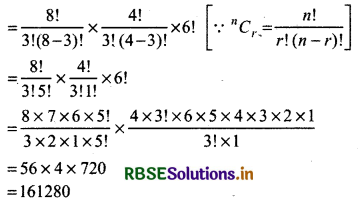
Thus, taking 3 consonants and 3 vowels no. of words formed = 161280.

Question 2.
How many ways 6 persons out of 4 teachers and 7 students, can be selected, when there must be
(i) only one teacher.
(ii) at least one teacher.
Answer:
(i) When there must be only one teacher.
In this case, 6 persons can be selected in the following ways:
1 teacher and 5 students
Now, no. of ways to select ¡ teacher out of 4 teachers = 4C1
and no. of ways to select 5 students out of 7 students = 7C5
Thus, total ways to select = 4C1 × 7C5
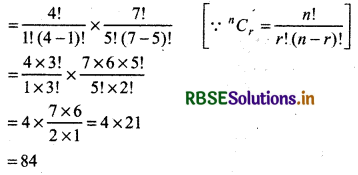
(ii) When at least one teacher is selected
In this case, 6 persons can be selected in the following ways
1 Teachers and 5 students can be select by = 4C1 × 7C5 ways
2 Teachers and 4 students can be select by = 4C2 × 7C4 ways
3 Teachers and 3 students can be select by = 4C3 × 7C3 ways
4 Teachers and 2 students can be select by = 4C4 × 7C2 ways
All four methods are mutually exclusive
Thus, total no. of ways of selection
= 4C1 × 7C5 + 4C2 × 7C4 + 4C3 × 7C3 + 4C4 × 7C2
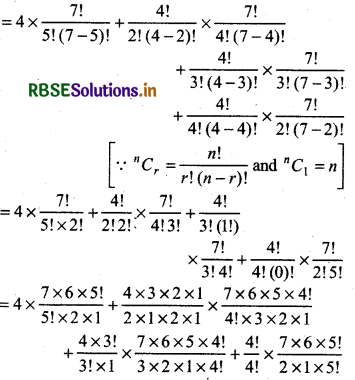
= 2 × 7 × 6 + 6 × 35 + 4 × 35 + 1 × 21
= 84 + 210 + 140 + 21
= 455
Question 3.
How many ways 7 green and 5 yellow balls can be arrange in a row whereas any two yellow balls never placed together?
Answer:
Let each green ball is represented by 'H' .......
...H...H...H...H...H...H...H
If we placed 7 green balls in a row at same distance then:
We get total 8 places where yellow balls can placed with given condition as shown in above figure.
Thus, required method of selection
= No. of ways to fill 8 blank spaces with 5 yellow balls
= 8C5 = \(\frac{8 !}{5 !(8-5) !}\) [∵ nCr = \(\frac{n !}{r !(n-r) !}\)]
= \(\frac{8 !}{5 ! 3 !}=\frac{8 \times 7 \times 6 \times 5 \times 4 \times 3 !}{5 \times 4 \times 3 ! \times 3 \times 2 \times 1}\) = 56

Question 4.
How many ways Mohan can invite at least one friend out of 4 friends for lunch?
Answer:
To invite at least 1 friend means he can invite 1 or 2 or 3 or 4 friends.
Thus, total no. of ways to invite the friends
= 4C1 + 4C2 + 4C3 + 4C4
= 4 + 6 + 4 + 1 = 15
Question 5.
There are 6 girls and 8 boys in a group then how many ways a team of 7 members can be selected. If team contains
(i) no girl.
(ii) at least 1 boy and 1 girl.
Answer:
(i) No girl in team
Then there will be all boys in team
Thus, selection of 7 boys out of 8 can be done by 8C1 ways
Thus, total ways = 8C7
= \(\frac{8 !}{7 !(8-7) !}\) [∵ nCr = \(\frac{n !}{r !(n-r) !}\)]
= \(\frac{8 \times 7 !}{7 ! \times 1 !}\) = 8
(ii) At least I boy and I girl
Then possible ways to select a team
(a) 6 boys and 1 girl
(b) 5 boys and 2 girls
(c) 4 boys and 3 girls
(d) 3 boys and 4 girls
(e) 2 boys and 5 girls
(f) 1 boy and 6 girls
No. of ways to select 6 boys and 1 girl = 8C6 × 6C1
No. of ways to select 5 boys and 2 girls = 8C5 × 6C2
No. of ways to select 4 boys and 3 girls = 8C4 × 6C3
No. of ways to select boys and 4 girls = 8C3 × 6C4
No. of ways to select 2 boys and 5'girls = 8C2 × 6C5
No. of ways to select 1 boy and 6 girls = 8C1 × 6C6
Thus, total no. of ways to -select team
= 8C6 × 6C1 + 8C5 × 6C2 + 8C4 × 6C3 + 8C3 × 6C4 + 8C2 × 6C5 + 8C1 × 6C6
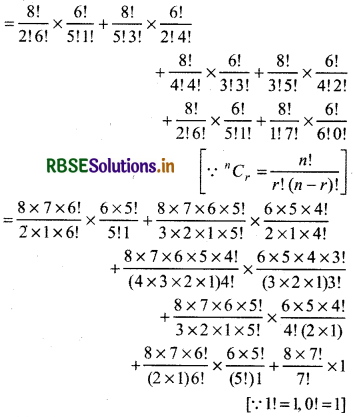
= 28 × 6 + 8 × 7 × 15 + 70 × 20 + 56 × 15 + 28 × 6 + 8 × 1
= 168 + 840 + 1400 + 840 + 168 + 8
= 3424

Question 6.
Taking 8 men and 5 women, a committee of 6 members has to be formed. How many ways this committee can be formed whereas each committee:
(i) consist of only 2 men
(ii) consist of only 2 women
(iii) consist of at least 2 women
(iv) consist of at least 2 men
Answer:
(i) 2 men from 8 men can be selected by 8C2 ways and rest 4 is taken from 5 women by 5C4 ways.
∴ Required number = 8C2 × 5C4 = 28 × 5 = 140.
(ii) 2 women from S can be selected by 5C2 ways and rest 4 from 8 men can be selected by 8C4 ways.
∴ Required number = 5C2 × 8C4 = 10 × 70 = 700.
(iii) For taking at least 2 women, we can select by following ways:
2 women and 4 men, 3 women and 3 men,
4 women and 2 men, 5 women and I men
So these will be selected by
5C2 × 8C4; 5C3 × 8C3; 5C4 × 8C2; 5C5 × 8C1
ways respectively.
∴ Required number
5C2 × 8C4; 5C3 × 8C3; 5C4 × 8C2; 5C5 × 8C1
= 700 + 560 + 140 + 8 = 1408
(iv) From above method, by taking at least 2 men,
form a total number of ways :
8C2 × 5C4 + 8C3 × 5C3 + 8C4 × 5C2 + 8C5 × 5C1 + 8C6
= 140 + 560 + 700 + 280 + 28
= 1436
Question 7.
How many 3-digit numbers less than 1000 can be formed using the digits 1, 2, 3, 4, 5, 6, if no digits ¡s repeated?
Answer:
Given number of digits 6
For forming 3-digit number, we have to choose of the three digit from these 6-digits.
Hence, total numbers which have 3 digits
= 6p3 = \(\frac{6 !}{3 !}\) = \(\frac{6 \times 5 \times 4 \times(3) !}{(3) !}\)
= 6 × 5 × 4 = 120.
Question 8.
How many ways 15 members of a committee can sit around the round table whereas secretary sit on one side and vice secretary on other side of director?
Answer:
Total number of members 15
Here, the position of secretary, vice secretary and director are fixed but there is no condition of clockwise and anti clockwise
Hence, total number of sitting ways according to condition = 2 !
Now, we can change the position of 12 members only.
Hence, total number sitting ways of 12 members = 12!
Hence, total number of ways 15 members sit according to given condition.
= 12! × 2!

Question 9.
There are 15 stations on a railway line. For this, how many different tickets of a class should be printed such that any person from any station can buy ticket of other station of this line?
Answer:
Total number of stations = 15
A person buy a ticket on a station then we can buy tickets of remaining 14 stations.
Hence, total number of methods of printing 14 tickets out of 15 tickets.
= 15P14 = \(\frac{15 !}{14 !}\) = \(\frac{15 \times 14 !}{14 !}\) = 15
∵ One ticket can be printed in 2 ways in this way total 14 tickets will be printed.
Hence, total number of ways tickets be printed for 15 stations are
= 15 × 14 = 210.
Question 10.
How many ways 10 different beads can be threads for making a garland wheareas 4 special beads never remain separate ?
Answer:
4 out of 10 beads do not remain together then Total remaining beads = 10 - 4 = 6
Hence, the methods of making a garland using 6 beads = 6!
If 4 out of 10 beads do not remain together then the method of making a garland = 6 ! × 4 !
As in a garland there is no difference between clockwise and anticlockwise, so, methods to make a garland with 10 different beads.
= \(\frac{6 ! \times 4 !}{2}\)
= \(\frac{6 \times 5 \times 4 \times 3 \times 2 \times 4 \times 3 \times 2}{2}\)
= 8640.
Question 11.
How many numbers can be formed using digits 0,1,2,..,, 9 which is more than or equal to 6000 and less than 7000 and is divisible by 5 whereas any number can be repeated as many times ?
Answer:
The numbers which are more than or equal to 6000 and less than 7000 and is divisible by 5 has 6 on thousand’s place and 0 or 5 on one’s place and number is 4 digits number. As digits can be repeated.
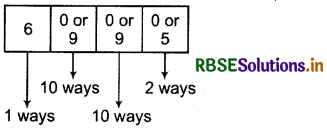
Hence, total numbers = 1 × 10 × 10 × 2
= 200
Question 12.
How many words can be formed from letters of word SCHOOL, whereas both O’s not come together ?
Answer:
There are total 6 letters in word SCHOOL.
In it there are 2 O’s and other letters are different then the number of total permutations = \(\frac{6 !}{2 !}\)
If 2 O’s take together then it will take as one letter then number of permutations taking 2 O’s together = 5 !
Hence, number of permutations when 2 O’s are not together are
= \(\frac{6 !}{2 !}\) - 5!
= \(\frac{6 \times 5 \times 4 \times 3 \times 2 !}{2 !}\) - 5!
= 6 × 5 × 4 × 3 - 5 × 4 × 3 × 2
= 360 - 120
= 240.

Question 13.
If the letters of the word ‘RANDOM’ are arranged in a dictionary in order then find the rank of this word.
Answer:
There are 6 letters in the word ‘RANDOM’ and in order of alphabet these comes ‘ ADMNOR’ so therefore
(i) no. of words start with 'A' are
A ××××× = 5! = 120
(ii) no. of words start with ‘D’ are
D ××××× = 5! = 120
(iii) no. of words start with ‘M' are
M××××× = 5! = 120 ,
(iv) no. of words start with 'N’ are
N ××××× = 5!=120
(v) no. of words start with ‘O' are
O××××× = 5! = 120
(vi) no. of words start with 'RAD' are
RAD××× = 3! = 6
(vii) no. of words start with ‘RAM’ are
RAM × × × = 3! =6
(viii) no. of words start with ‘RANDOM’ is
RANDOM × = 1
(ix) word next to the word RANDOM is RANDOM
so therefore rank of word ‘RANDOM’ is
120 + 120 + 120 + 120 + 120 + 6 + 6 + 1 + 1 = 614th
Question 14.
A box contains two white, three black and four red balls. Determine the number of ways in which three balls can be selected from this box, in which at least one black ball is compulsory.
Answer:
Total number of balls in the box
= 2 + 3 + 4 = 9
For at least one black ball we can choose it in the following ways :
|
White = 2 |
Black = 3 |
Red = 4 |
|
1 |
1 |
1 |
|
2 |
1 |
0 |
|
0 |
1 |
2 |
|
1 |
2 |
0 |
|
0 |
2 |
1 |
|
0 |
3 |
0 |
Total number of permutation according to the table
= (2C1 × 3C1 × 4C1) + (2C2 × 3C1 × 4C0) + (2C0 × 3C1 × 4C1) + (2C0 × 3C3 × 4C0)
+ (2C0 × 3C2 × 4C1) + (2C0 × 3C3 × 4C0)
= (2 × 3 × 4) + (1 × 3 × 1) + (1 × 3 × 6) + (2 × 3 × 1) + (1 × 3 × 4) + (1 × 1 × 1)
= 24 + 3 + 18 + 6 + 12 + 1
= 64

Question 15.
By 6 different coloured flags, taking one or more than one how many ways signal can be given ?
[Hint: 6C1 × 1! + 6C2 × 2! + 6C3 × 3!
+ 6C4 × 4! + 6C5 × 5 ! + 6C6 × 6 !]
Answer:
Total number of coloured flags = 6
Hence we can take any colour from 1 to 6.
Thus, the number of signals formed by using 6 different types of coloured flags
= 6C1 × 1! + 6C2 × 2! + 6C3 × 3!
+ 6C4 × 4! + 6C5 × 5 ! + 6C6 × 6 !
= 6 × 1 + 15 × 2 + 20 × 3 × 2 + 15 × 4 × 3 × 2 + 6 × 5 × 4 × 3 × 2 + 1 × 6 × 5 × 4 × 3 × 2
= 6 + 30+120 + 360 + 720 + 720
= 1956.
Question 6.
Number of diagonals in a polygon is 44 then find number of its sides.
Answer:
Number of diagonals = 44
Formula: Number of diagonals = \(\frac{n(n-3)}{2}\)
where n = number of sides.
⇒ \(\frac{n(n-3)}{2}\) = 44
⇒ n2 - 3n = 88
⇒ n2 - 3n - 88 = 0
On solving n = 11, -8
∵ Negative number is not possible.
Hence, number of sides = 11.
Question 17.
How many numbers can be formed taking 4 digits from digits 1, 2, 3, 4, 5, 6 whereas digit 4 and 5 are compulsory ?
Answer:
Total number of digits = 6
We have to take 4 digits but digit 4 and 5 are compulsory. Thus, we have to choose only 2 digits out of 6 - 2 = 4 digits.
Now, the numbers formed by using 4 digits is 4P4. Hence required number
= 4C2 × 4P4
= \(\frac{4 \times 3}{2 \times 1}\) × 4!
= 6 × 24 = 144
Question 18.
In how many ways 6 '+’ and 4 '-' sign can be kept in a line whereas any two occur together ?
Answer:
First we put '+’ in a line. This can be done in 1 way because all ‘+’ are same.
+ + + + + +
Now we put in the following way
- + - + - + - + - + -
Hence, the method of putting sign in 4 out of 7 places = 7c4 × 1 because signs are same.
∴ Total number of ways 6 '+’ and 4 ‘-' sign occur together
= 1 × 7C4 × 1
= \(\frac{7 !}{4 ! 3 !}\) = 35

Question 19.
By 8 students and 5 professors, we have to make a college council, taking 5 students and 2 professors. How many councils can be formed ?
Answer:
Number of methods of choosing 5 out of 8 students = 8C5
and number of methods of choosing 2 out of 5 professors = 5C2
∴ By the basic principle of calculation the methods of choosing 5 out of 8 students and 2 out of 5 professors are
= 8C5 × 5C2
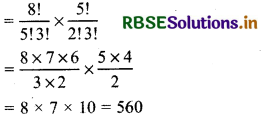
Hence, required councils are 560.
Question 20.
In how many ways can one select a cricket team of 11 from 14 players in which at least 2 bowlers are compulsory' whereas only 4 players can bowl. How many ways this team can be formed ?
Answer:
The method of choosing 2 out of 4 bowlers is 4C2 and the method of choosing 9 out of remaining to players 10C9. Similarly, we Can find the methods for 3 and 4 bowlers.
Hence, total number of ways to select 11 players out of 14 players
= 4C2 × 10C9 + 4C3 × 10C8 + 4C4 × 10C7
Question 21.
Find the number of chords passing through 11 points on circumference of a circle.
Answer:
Number of point on circumference of circle = 11
We know that a chord is formed by joining two points.
Hence taking 2 points out of 11 points number of chords
= 11C2

Hence, number of chords = 55.
Question 22.
There are n points in a plane in which m points are collinear. How many triangles will be formed by joining three points ?
Answer:
For making a triangle we need three points thus if 3 points out of n points are not in a line, then nC3 triangle can be formed by n points but m point is in a line, thus mC3 triangle forms less.
Hence, required number of triangles
= nC3 - mC3

Question 23.
Find the number of diagonals of a decagon.
Answer:
There are 10 vertices in a decagon. Now by joining two vertices we get a side of decagon or a diagonal.
Hence, number of line segment by joining of vertices of decagon = number of ways taking 2 points out of 10 points
= 10C2 = \(\frac{10(10-1)}{2 !}\)
Now, there are 10 sides of decagon in 10C2 line segment
∴ Required number of diagonals
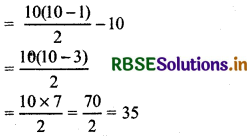
Hence, number of diagonals are 35.
Question 24.
There are 5 empty seats in a train, then in how many ways three travellers can sit on these seats ?
Answer:
Number of ways of seating of 3 travellers out of 5 seats.
= 5P3
= \(\frac{5 !}{(5-3) !}\)
= \(\frac{5 \times 4 \times 3 \times 2 !}{2 !}\)
= 60
Hence, 3 travellers can be seated by 60 ways.
Question 25.
A group of 7 has to be formed from 6 boys and 4 girls. In how many ways group can be formed if boys are in majority in this group ?
Answer:
Number of boys = 6
Number of girls = 4
Number of members in the group = 7
One putting boys in majority in the group We have to choose in the following ways:
4 boys + 3 girls
5 boys + 2 girls
6 boys + 1 girl
Number of ways choosing 4 boys and 3 girls = 6C4 × 4C3
Number of ways choosing 5 boys and 2 girls = 6C5 × 4C2
Number of ways choosing 6 boys and 1 girl = 6C6 × 4C1
Required number of ways forming the group
= 6C4 × 4C3 + 6C5 × 4C2 + 6C6 × 4C1
= 15 × 4 + 6 × 6 + 1 × 4
= 60 + 36 + 4 = 100
Hence, group can be formed by 100 ways.

Question 26.
In the conference of 8 persons, every person handshake with each other only once, then find the total number of handshaked.
Answer:
When two persons shakes hand with each other, then this is taken as one handshake.
Hence, the number of handshake is equal to choosing 2 persons out of 8 persons.
∴ Number of handshaked
= 8C2 = \(\frac{8 !}{2 !(8-2) !}=\frac{8 \times 7 \times 6 !}{2 \times 1 \times 6 !}=\frac{56}{2}\) = 28
Hence, required number of handshaked is 28.
Question 27.
In how many ways 6 men and 6 women can sit around the round table whereas any two women never sit together ?
Answer:
First we sit the men in a order that there is a place vacant between two men.
Then, number of ways sitting 6 men = (6 - 1)! = 5 !
Now number of ways sitting 6 women in the vacant places = 6 !
∴ Number of permutations = (6 - 1) ! = 5 !
Now, number of ways sitting 6 women in the vacant place = 6!
∴ Number of permutations = 5 ! × 6 !
= (5 × 4 × 3 × 2 × 1) × (6 × 5 × 4 × 3 × 2 × 1)
= 86400.
Multiple Choice Questions
Question 1.
12P2 equals:
(a) 132
(b) 131
(c) 232
(d) None of these
Answer:
(a) 132
Question 2.
If 15Pr = 2730 then r equals:
(a) 6
(b) 3
(c) 9
(d) None of these
Answer:
(b) 3
Question 3.
If 9Pr = 60480 then r equals:
(a) 3
(b) 6
(c) 12
(d) None of these
Answer:
(b) 6

Question 4.
If 16. nP3 = 13. n + 1P3, then n equals:
(a) 15
(b) 12
(c) 10
(d) None of these
Answer:
(a) 15
Question 5.
If nP6 = 30. nP4 then n equals:
(a) 10
(b) 5
(c) 8
(d) None of these
Answer:
(a) 10
Question 6.
If nP4 . n - 1P3 = 9 : 1 then n equals:
(a) 9
(b) 6
(c) 12
(d) None of these
Answer:
(a) 9
Question 7.
nCr + nCr + 1 equals:
(a) 9
(b) 5
(c) 12
(d) None of these
Answer:
(a) 9
Question 8.
nPr equals :
(a) r! × (nCr)
(b) \(\frac{{ }^n C_r}{r !}\)
(c) r.nCr
(d) None of these
Answer:
(a) r! × (nCr)
Question 9.
n - 1Cr + n - 1Cr - 1 equals :
(a) nCr
(b) n - 1C2r
(c) (2n - 1)Cr
(d) None of these
Answer:
(a) nCr
Question 10.
No. of ways to select team of 11 players out of 14 players:
(a) 360
(b) 364
(c) 120
(d) None of these
Answer:
(b) 364

Question 11.
No. of ways 4 persons can sit at three empty seats:
(a) 4
(b) 6
(c) 8
(d) None of these
Answer:
(a) 4
Question 12.
Number of hexagon formed by taking 10 points on circumference of circle:
(a) 210
(b) 120
(c) 216
(d) None of these
Answer:
(a) 210
Question 13.
If nC5 = nC1 then nP3 equals:
(a) 12
(b) 6
(c) 18
(d) None of these
Answer:
(a) 12
Question 14.
If 2nC3 : nC2 = 44 : 3 then value of n is :
(a) 6
(b) 12
(c) 3
(d) None of these
Answer:
(a) 6
Question 15.
47C4 + \(\sum_{r=1}^5\) (52 - r)C3 equals :
(a) 52C4
(b) 52C3
(c) 52C6
(d) None of these
Answer:
(a) 52C4
Question 16.
No. of ways to constitute a team of 11 members out of 6 teachers and 8 students :
(a) 364
(b) 120
(c) 168
(d) None of these
Answer:
(a) 364

Question 17.
If n+1C3 = 2. nC2 then n equals :
(a) 5
(b) 3
(c) 6
(d) None of these
Answer:
(a) 5
Question 18.
Find the total number of ways of distributing 5 different balls in to 3 boxes :
(a) 243
(b) 150
(c) 6
(d) 125
Answer:
(a) 243
Question 19.
Total ways to select pen out of 10 pens :
(a) 210 - 1
(b) 210
(c) 29
(d) None of these
Answer:
(a) 210 - 1
Question 20.
Number of 5 member committees out of 7 men and 7 women. In which at least 2 women exist in each committee is:
(a) 91
(b) 92
(c) 108
(d) None of these
Answer:
(d) None of these
Question 21.
Number of ways to kept 7 green and 5 red balls in a row whereas no two red balls exist together, are:
(a) 56
(b) 112
(c) 120
(d) None of these
Answer:
(a) 56
Question 22.
Number of combinations formed by 5 pens, 3 pencils and 4 rubber is :
(a) 119
(b) 120
(c) 60
(d) None of these
Answer:
(c) 60

Question 23.
No. of ways of 3 prize distribution to 6 players whereas any player can get how many prizes are:
(a) 63
(b) 64
(c) 66
(d) None of these
Answer:
(a) 63
Question 24.
Number of diagonals in hexagon is :
(a) 9
(b) 6
(c) 12
(d) None of these
Answer:
(a) 9
Question 25.
In a plane out of 12 points 5 are collinear, then triangle formed by these points are :
(a) 210
(b) 120
(c) 320
(d) None of these
Answer:
(a) 210
Question 26.
There are 4 letters and 4 envelopes with address when any 4 letters are not dropped in right envelope then total ways are :
(a) 9
(b) 10
(c) 16
(d) None of these
Answer:
(a) 9
Question 27.
There are 44 diagonals in a polygon then number of sides in polygon is:
(a) 11
(b) 7
(c) 8
(d) None of these
Answer:
(a) 11

Question 28.
Using letters of the word ‘EAMCET’ words sfre formed when two vowels are not together then number of words is :
(a) 72
(b) 144
(c) 360
(d) None of these
Answer:
(d) None of these
Question 29.
Number of ways to choose 5 white and 4 red balls out of 10 white and 8 red balls are :
(a) 10C5 × 8C4
(b) 8C5 × 10C4
(c) 10C8 × 8C5
(d) None of these
Answer:
(a) 10C5 × 8C4
Question 30.
930 Diwali cards are distributed among students of a class. Each student send card to each remaining student then number of student in a class is:
(a) 31
(b) 32
(c) 93
(d) None of these
Answer:
(a) 31
Fill in the blanks
Question 1.
The value of 0! = ................................
Answer:
1
Question 2.
The number of arrangement taken 5 at a time out of n distinct element (Repitition is allowed) ................................
Answer:
n5
Question 3.
If nPr = 840, ncr = 35 then r = ................................
Answer:
4
Question 4.
The value of 15C8 + 15C9 - 15C6 - 15C7 = ..........................................
Answer:
0
Question 5.
The number of six-digit number, all digits of which are odd is ...........................................
Answer:
56

Question 6.
The number of diagonals of n sided polygon is .............................................
Answer:
(nC2 - n)
Question 7.
The number of possible out comes when a coin is tossed 6 times is .........................................
Answer:
26
Question 8.
If nC10 = nC4 then value of n is ..............................................
Answer:
14
Question 9.
A convex polygon has 54 diagonals, then number of its sides are .......................................................
Answer:
12
Question 10.
Number of triangle are made from 15 collinear points ..................................................
Answer:
455
Question 11.
How many ways 5 girls and 3 boys be seated in a row so that no two boys are together ..............................................
Answer:
14400
Question 12.
100! = ..................................... 99.98.97!
Answer:
100
Question 13.
The value of 10.9! = .......................................
Answer:
10
Question 14.
The value of nCn = ..........................................
Answer:
1
Question 15.
The value of nPn = ............................................
Answer:
n!

State whether the statements True or False.
Question 1.
The Value of 5P5 = 5
Answer:
False
Question 2.
The value of 10C9 = 10
Answer:
True
Question 3.
If some or all of n objects are taken at a time, then number of combination is 2n - 1
Answer:
True
Question 4.
Three letters can be posted in five letter boxes is 35 ways.
Answer:
False
Question 5.
There are 12 points in a plane of which 5 points are collinear then the number of lines by joining these points in pairs is 12C2 - 5C2.
Answer:
False
Question 6.
The no. of arrangements when out of 10 different things 5 taken at a times is 10P5.
Answer:
True
Question 7.
The number of selection when 2 men are selected from 5 men is 5C2.
Answer:
True
Question 8.
The number of selection of n different thing taken 5 at a time is nC0.
Answer:
False
Question 9.
The number of arrangement always greater than the number of selections.
Answer:
False

Question 10.
If nCx = nCy, then x = n - y.
Answer:
True

- RBSE Solutions for Class 11 Maths Chapter 3 त्रिकोणमितीय फलन Ex 3.1
- RBSE Solutions for Class 11 Maths Chapter 2 संबंध एवं फलन विविध प्रश्नावली
- RBSE Solutions for Class 11 Maths Chapter 2 संबंध एवं फलन Ex 2.3
- RBSE Solutions for Class 11 Maths Chapter 2 संबंध एवं फलन Ex 2.2
- RBSE Solutions for Class 11 Maths Chapter 2 संबंध एवं फलन Ex 2.1
- RBSE Solutions for Class 11 Maths Chapter 1 समुच्चय विविध प्रश्नावली
- RBSE Solutions for Class 11 Maths Chapter 1 समुच्चय Ex 1.6
- RBSE Solutions for Class 11 Maths Chapter 1 समुच्चय Ex 1.5
- RBSE Solutions for Class 11 Maths Chapter 1 समुच्चय Ex 1.4
- RBSE Solutions for Class 11 Maths Chapter 1 समुच्चय Ex 1.3
- RBSE Solutions for Class 11 Maths Chapter 1 समुच्चय Ex 1.2